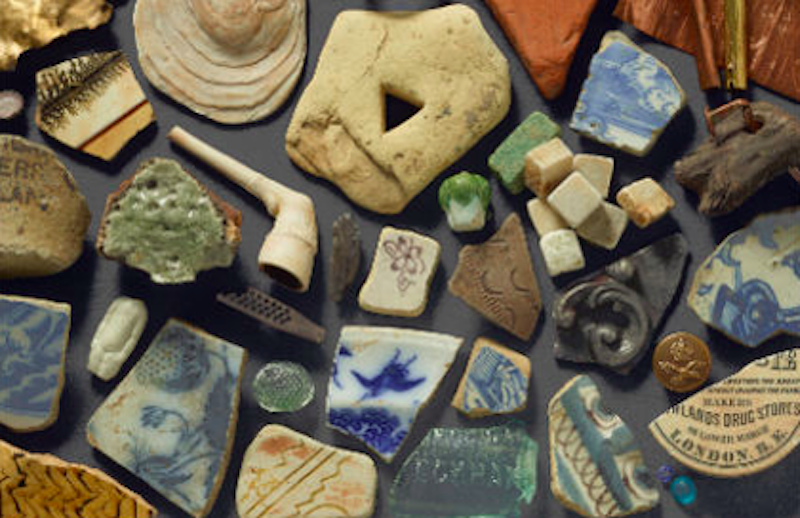Mudlarking in London isn't a pretty hobby—it’s got mud right in the name, so it’s not for you if you like beachcombing in pretty pedicures—but it's a fascinating one. I first wrote about mudlarking last January and mentioned my very favorite mudlark to follow on social media, Ted Sandling (@London_mudlark on Instagram). His photos are flawless, and always accompanied by detailed, humorous, insightful commentary about the selected historical shards he's plucked from the muddy banks of the Thames.
His new book London in Fragments: A Mudlark's Treasure releases September 1 from Frances Lincoln Press and I was thrilled to snatch an early copy. Followers eagerly await Sandling's posts of historical finds and I couldn't wait to see what treasures and information the pages of the 256-page hardcover held.
The foreword is provided by British author Iain Sinclair, who describes “the sound and smell of dying centuries” of the "river highway" at Thames which provides the setting for the journey the book will undertake: “In the golden hour, when the liquid carpet rolls back, we are free to comb and trawl without challenge, to carry home choice shards from which we can almost taste the biographies of those who were here before us.”
Sinclair aptly describes the true passion of the beachcomber and the impetus for this book, gorgeously compiled by Sandling with his ability to choose the quirkiest, period-representative and most aesthetically pleasing shards to rise from the muddy depths of the River Thames to use as examples of the centuries of history that lie waiting to be unearthed by mudlarkers like Ted who come there in search of treasures on its shores.
Sandling fell in love with mudlarking one day when he walked to the Thames and found an 1850 clay pipe shaped like a horse’s hoof. He was instantly hooked. “Here in the centre of London, below the drinkers of the Founders Arms, I was holding history: not of great political events, but of very small things, of an individual living around 1850 who had broken his pipe and chucked it in the river,” says Sandling. “There is a connection there, between him and me, a participation in the same story. The same object, fresh from the beach, held for the first time in a hundred years, suddenly has a spark of life to it: it is fascinating because it is found.”
London in Fragments: A Mudlark's Treasure includes a historical background on how mudlarks came to be (at first they were young poor boys who’d search for coins and valuable items to sell), and then breaks down treasures found in the river into categories: Figures and Flowers, Pleasure and Vice, Clay Tobacco Pipes, Pleasures of the Table, A Mudlark’s Treasures, Industry, Anatomy of a Pottery, Tiles, Adornment, Indulgences and Comforts, and lastly a chapter on “So You Want to Go Mudlarking?” with tips and advice for those interested in seeking treasure on London’s shoreline.
Although I’m passionate about sea pottery, in the U.S. we don’t always find items as old as mudlarkers in London do. However, the book offers such great detail about ceramic history that I’m now able to identify many of my beachcombing finds that may have been passed down for generations before ending up on the beach. As a sea glass hunter, I loved learning about industrial glass cullet, and there’s a great deal of historical informational about bottles, where the majority of our sea glass comes from. Sandling features some faceted sea glass gems in the book that are the envy of any enthusiast. He discusses Frozen Charlotte dolls, metal items and many other beachcombing finds, all with the universal theme of our connections to the past through our treasures, so the book isn’t just for Londoners, there’s much to be learned for beachcombers worldwide.
—Read more of Mary McCarthy’s articles about beachcombing or follow her beachcombing finds on Instagram.

